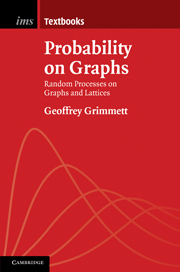Book contents
- Frontmatter
- Contents
- Preface
- 1 Random walks on graphs
- 2 Uniform spanning tree
- 3 Percolation and self-avoiding walk
- 4 Association and influence
- 5 Further percolation
- 6 Contact process
- 7 Gibbs states
- 8 Random-cluster model
- 9 Quantum Ising model
- 10 Interacting particle systems
- 11 Random graphs
- 12 Lorentz gas
- References
- Index
10 - Interacting particle systems
Published online by Cambridge University Press: 05 June 2012
- Frontmatter
- Contents
- Preface
- 1 Random walks on graphs
- 2 Uniform spanning tree
- 3 Percolation and self-avoiding walk
- 4 Association and influence
- 5 Further percolation
- 6 Contact process
- 7 Gibbs states
- 8 Random-cluster model
- 9 Quantum Ising model
- 10 Interacting particle systems
- 11 Random graphs
- 12 Lorentz gas
- References
- Index
Summary
The contact, voter, and exclusion models are Markov processes in continuous time with state space {0, 1}V for some countable set V. In the voter model, each element of V may be in either of two states, and its state flips at a rate that is a weighted average of the states of the other elements. Its analysis hinges on the recurrence or transience of an associated Markov chain. When V = ℤ2 and the model is generated by simple random walk, the only invariant measures are the two point masses on the (two) states representing unanimity. The picture is more complicated when d ≥ 3. In the exclusion model, a set of particles moves about V according to a ‘symmetric’ Markov chain, subject to exclusion. When V = ℤd and the Markov chain is translation-invariant, the product measures are invariant for this process, and furthermore these are exactly the extremal invariant measures. The chapter closes with a brief account of the stochastic Ising model.
Introductory remarks
There are many beautiful problems of physical type that may be modelled as Markov processes on the compact state space = {0, 1}V for some countable set V. Amongst the most studied to date by probabilists are the contact, voter, and exclusion models, and the stochastic Ising model.
- Type
- Chapter
- Information
- Probability on GraphsRandom Processes on Graphs and Lattices, pp. 190 - 204Publisher: Cambridge University PressPrint publication year: 2010

